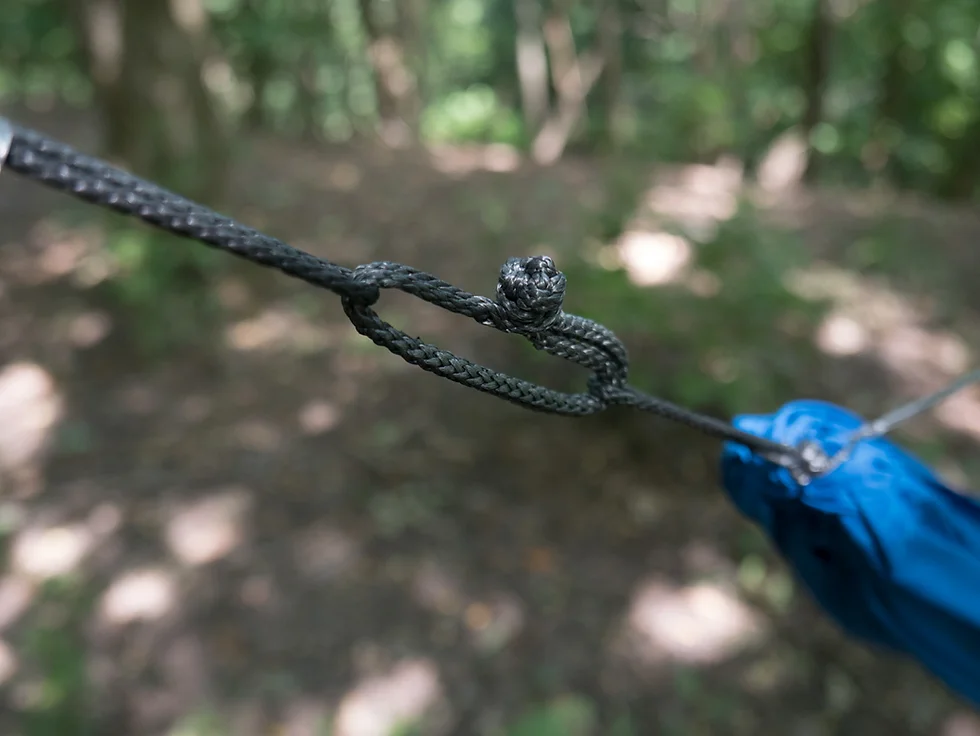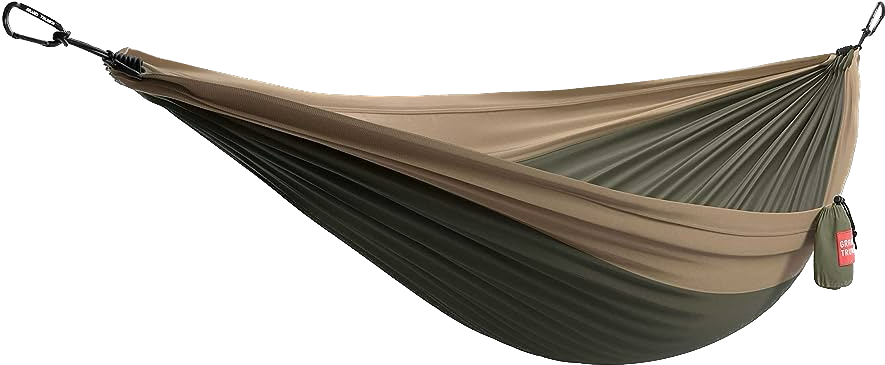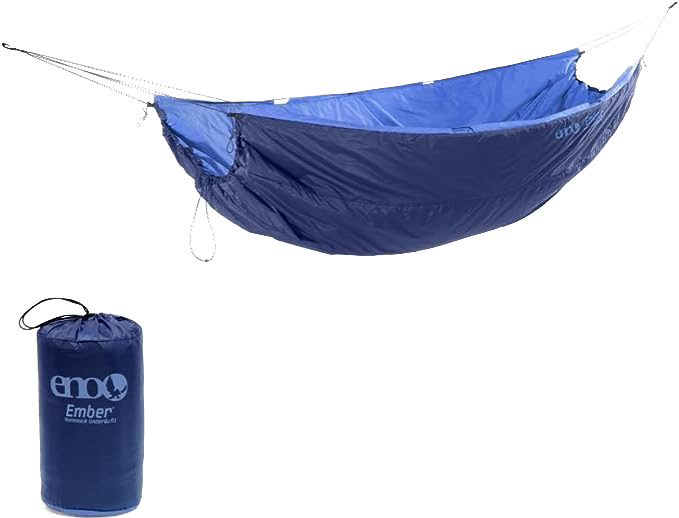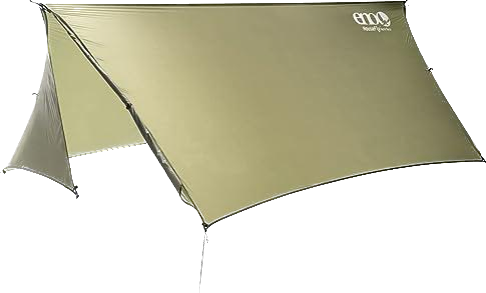If you’re an avid backpacker or hammock goer you may have heard of the term whoopie slings. Have you ever wondered what these are, how they work, or how they’re related to hammocking?
Well in this article we’ll cover the basics of hammock whoopie slings. We’ll go over what are whoopie slings, set-up tips, and how to select the right type of whoopie sling that fits with your hammock. We’ll even cover how to make one yourself, DIY style. Let’s get into it!
Short Summary
What is a whoopie sling in hammocking?
Whoopie slings, also spelled woopie slings, are adjustable ropes with an adjustable loop used as hammock suspension systems. They provide secure and comfortable support for your hammock. Additionally, these sling loops may be paired with whoopie hooks to make adjusting tension or height easier when hanging a hammock – essentially replacing typical daisy chain straps.
The main benefit of using a whoopie sling is that they offer more flexibility than ropes or hammock straps. This makes it perfect for customizing your hammock to have the right hang and firmness depending on different setups and areas.
- Whoopie Slings are a lightweight, adjustable, and tree-friendly essential for hammocking.
- They provide infinite adjustability to ensure a secure and comfortable setup.
- Consider factors such as material, strength, length & weight limit when selecting the right whoopie sling for your hammock.
Let’s continue diving into some of the basics of hammock whoopie slings.
What are Whoopie Slings: A Hammock Essential
Whoopie slings are lightweight and adjustable ropes used in hammock suspension systems. They are compact in design and allow the user to adjust their hammock tightness and sag. Because of this customization, hammock enthusiasts often go for a complete whoopie suspension system over typical hammock straps.
Components of Whoopie Slings
Whoopie slings can be broken down into three main components:
- The adjustable loop, which attaches to tree huggers or straps for adjusting the length.
- The fixed loop at one end is used to attach it to your hammock.
- The bury section is made up of a cord that tightens up tension on the sling itself when you hang it.
Accessories such as whoopie hooks or Dutch biners can help Streamline this process by providing an easy means for attaching slings quickly but are not necessary.
Setting Up and UsingYour Hammock Whoopie Slings
Ready to go try out whoopie slings? Let’s walk you through step by step on what you need and how to set up your hammock whoopie slings.
Materials Needed:
- Hammock with gathered ends (preferably with continuous loops)
- Whoopie slings (usually made of Amsteel or Dyneema)
- Carabiners or hardware (optional, but can make the setup easier)
- Tree-friendly straps or tree huggers (to protect the trees)
- Alternatively, you can get the entire DD Hammock Whoopie Sling Suspension. (All you’ll need is the hammock)
Setting up hammock whoopie slings is fairly simple and only takes 8 easy steps.
Step 1: Prepare the whoopie slings A whoopie sling has two adjustable loops: a fixed loop (bigger) on one end and a continuous loop (smaller) on the other. Adjust the continuous loop by pulling the fixed loop away from it. This will shorten the sling, allowing you to easily adjust the length later during setup.
Step 2: Wrap tree straps around the trees If you’re using tree straps or webbing, wrap them around the trees at a height slightly above your shoulder level. Ensure the straps are secure and that there’s no slack. If you’re using tree-friendly straps, follow the manufacturer’s instructions.
Step 3: Connect the whoopie slings to the hammock Take the fixed loop of one whoopie sling and pass it through the hammock’s continuous loop at one end (gathered end). This will be your attachment point. Repeat the same process on the other side of the hammock.
Step 4: Hang the hammock With the whoopie slings connected to the hammock, it’s time to hang it between the trees. Start by adjusting the length of each whoopie sling to your desired hang height. You can shorten or lengthen the slings by pulling or releasing the continuous loop.
Step 5: Achieve the right hang angle Aim for a 30-degree hang angle. You can use a hammock suspension calculator or smartphone app to help you find the correct hang angle. Adjust the height of the straps on the trees to achieve the desired hang angle.
Step 6: Test the setup Carefully sit in the hammock and check for comfort and stability. Make additional adjustments to the whoopie slings if needed to find the optimal position.
Step 7: Secure the hammock ends Once you’re happy with the setup, make sure the whoopie slings are securely attached to the hammock’s continuous loops. Double-check the tree straps to ensure they are tight and won’t slip.
Step 8: Enjoy! Your hammock should now be properly set up and ready to provide you with a relaxing and comfortable experience. Always remember to follow Leave No Trace principles and take care of the environment when camping or hammocking.
The Benefits of Using Whoopie Slings for Hammocking

Now that you have your whoopie slings set up, let’s talk through some of the advantages of using whoopie slings for hammocking. These advantages include the following:
- Lightweight and Compact – Whoopie slings are typically made from lightweight and strong materials like Amsteel or Dyneema, significantly reducing the overall weight of your hammock setup. This is especially advantageous for backpackers and hikers who want to minimize their pack weight.
- Adjustability and Customization – Whoopie slings offer excellent adjustability, allowing users to fine-tune the length of the suspension lines quickly and easily. This adjustability means you can easily adjust the hang angle and hammock tension to provide a comfortable and personalized hammock sleeping experience.
- Knotless System – Unlike traditional hammock straps that often require complex knots or hardware, whoopie slings use a knotless system with a continuous loop and a fixed loop. This simplifies the setup process, reduces the risk of mistakes, and makes it faster to set up and take down your hammock.
- Versatility – Whoopie slings can be used with various types of hammocks and suspension systems, making them a versatile choice for hammock campers. They work well with gathered-end hammocks, bridge hammocks, and asymmetrical hammocks, among others.
- Durable – Amsteel and Dyneema, the materials commonly used in hammock whoopie slings, are incredibly durable and have high tensile strength. This ensures that the slings can withstand the elements and provide a reliable suspension system for your hammock.
- Tree Friendly – Whoopie slings grip securely around trees without having to use straps like traditional tree huggers. This Enhances the eco-friendliness of these types of setups while preserving their structure for safe relaxation.
Overall, the combination of being lightweight, compact, adjustable, and easy to use makes hammock whoopie slings a popular and practical choice for hammock enthusiasts seeking a reliable and efficient suspension system for their outdoor adventures.
Choosing the Right Whoopie Sling for Your Hammock
Choosing a whoopie sling that is suitable for your hammock will help ensure you have an enjoyable and safe experience. When deciding on the right one, there are several factors to consider such as material, strength, length, and weight limit to compatibility with other accessories.
Here we’ll provide more information regarding these considerations so customers can make informed decisions. Including reviews from people already using them. This should aid in selecting the ideal whoopie sling for your particular hammock situation considering things like weight capacity and size before finally making a purchase decision.
Accessories and Compatibility
Before using a whoopie suspension system, you should check if your hammock is compatible. Some hammocks – like dd hammocks – come with continuous loops, making them ready to use with whoopie slings. Others do not and will need a quick adjustment or additional hardware to use a whoopie sling or whoopie hook.
When it comes to setting up a hammock tarp or rainfly, you’ll follow the usual steps. Essentially use guylines to position the tarp above your hammock and suspension system. Don’t forget to use a drip line on your whoopie sling to prevent water from flowing into your hammock.
Material and Strength
When selecting a partial or complete whoopie suspension system, the material and strength of it are essential elements for an enduring setup. Typically, whoopie slings are made from Amsteel or Dyneema because their durability and breaking strength compared to the weight ratio are remarkable.
Length and Weight Limit
When selecting a complete whoopie suspension system, two important aspects to consider are the length and weight limits.
For adjustable whoopie slings the average total adjustable length ranges from 6 to 12 fet (1.8 to 3.7 meters) or more. Fixed-length whoopie slings typically range from 4 to 7 feet (1.2 to 2.1 meters).
The weight capacity of hammock whoopie slings can vary, but most quality slings can comfortably support weights ranging from 300 to 500 pounds (136 to 227 kilograms) or more. Some heavy-duty versions might support even higher weights.
DIY Whoopie Slings: Making Your Own Hammock Suspension System
Whoopie slings are a popular choice for hammock campers due to their lightweight, adjustable, and easy-to-use design. In this section, we will guide you through the process of making your own Whoopie slings and explore how to properly use them to enhance your hammock camping experience.
Before we begin, please note that the information provided here is for entertainment purposes only. Always prioritize safety and consult with experts before attempting any high-risk activities.
Materials Needed:
- Strong and lightweight rope made of Amsteel or Dyneema with a diameter of 1/4 inch or 6mm. For each Whoopie sling, you will need approximately 12.5 feet (3.8 meters) of rope.
- Knife or scissors
- Fid or marlinspike (optional but helpful for splicing)
- Measuring tape or ruler
- Lighter (for melting and sealing the rope ends)
Step-by-Step Guide:
How to make Whoopie Slings
Step 1: Determine Rope Length
- Choose a strong and lightweight rope like 1/4-inch or 6mm Amsteel or Dyneema. For most hammocks, you’ll need around 12.5 feet of rope.
- This will create Whoopie slings that can adjust from approximately 20 inches to nearly 6 feet in length, giving you flexibility in setting up your hammock.
Step 2: Brummel Splice – Making the Fixed Loop
- Find the tail end of the rope and measure one fid length (around 5.25 inches) from the end. This will mark the spot where you’ll start the splice.
- Use a fid or marlinspike to create the brummel splice: Push the fid through the Amsteel, ensuring you have six strands on both sides of the fid to maintain full strength. Then, push the tail through the fid’s eye to form a loop.
- Cinch the first line (the tail) and the second line (the main part of the rope) together to secure the Brummel splice.
Step 3: Taper the End
- Measure approximately 1 to 2 inches from the end of the tail and start unraveling the rope progressively up the length. Cut the rope at intervals to create a smooth taper.
- To lock the Brummel splice, milk the tail by pulling on it to ensure it won’t come undone.
Step 4: Create the Loop
- Insert the Amsteel inside itself using two fids. Measure two fids from the end of the taper and mark that spot. Insert the fid through the Amsteel at the mark, staying in the center of the rope.
- Push the tail of the second fid onto the first fid and push them together, so they come out before reaching the taper.
- Milk the Amsteel by pulling the tails to lock the loop.
Step 5: Add a Stopper
- To prevent accidental loosening, bury the end of the Whoopie sling inside itself as if creating an eye splice.
- Pull the tail all the way through, milk it over the Amsteel, and cut the end at an angle. This will create a stopper that secures the loop.
Summary
It is a no-brainer that whoopie slings should be at the top of any hammock fan’s list when looking for an adjustable, tree-friendly, and lightweight suspension system. Their lightweight, adjustable, and knotless design makes them a popular choice among outdoor enthusiasts wanting an extremely easy and comfortable setup. Hammock whoopie slings allow users to have a tailored and personalized sleeping experience.
With all these benefits, it’s no wonder why one would want to enjoy their ultimate relaxation experience with this setup.



 Hello there, we're Vira Outdoors!
Hello there, we're Vira Outdoors!

